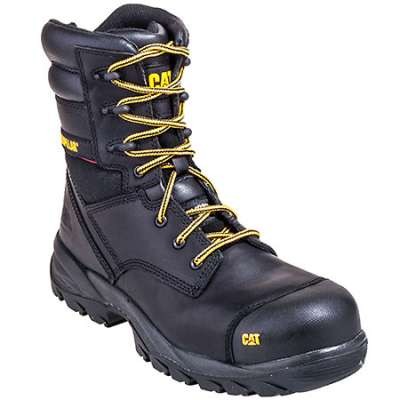There seems to be some controversy on whether a safety shoe with a steel toe can meet the ASTM Electrical Hazard Standard. The answer is, yes it can! Safety Shoes have had Electrical Hazard Standards for many years, even predating the development of Composite Material Safety Toes, so prior to Composite Toe Safety Shoes, all Electrical Hazard Safety Shoes had Steel Toes.
The Electrical Hazard test checks the ability of a new safety shoe to prevent an electrical charge leaking through the outsole into ground, and the safety toe type has nothing to do with the success or failure of this test. The Electrical Hazard safety shoes have to be built to hold the charge of 18,000 volts, at 60 Hz, for 1 minute, with no current flow or leakage to exceed 1.0 milli-amperes under dry conditions. The American Standard (ASTM 2413-11 Section 5.5 and ASTM2412-11) and the Canadian Standard (CSA Z195-09) for Electrical Hazard and/or Electric Shock (as the Canadians call it) were made the same in 2011 when the American Standard was changed effectively to be the same as the Canadian Standard. Thus this change eliminated the confusion about which standard was the strongest standard. They are both the same.
The standard does say that no metal may be used in the construction of the sole, but I believe some people think this includes the safety toe. It does not! This does mean that the shank of the safety shoe has to be made of a non-metallic material, and neither nails nor screws can be used in the heel or sole construction, unless they are made with non-metallic materials.
Prior to the onset of Composite Toe safety shoes, all Electrical Hazard safety shoes were steel toe, and today plenty of steel toe, Electrical Hazard safety shoes are available.
So what if the steel toe touches an electrical source. Well, the sole is still going to protect the wearer because the sole and the sole’s construction are what insulate the shoe and the wearer from being grounded. So what if the wearer is kneeling down and the steel toe is touch the ground and the person contacts a live electrical source? The grounding will take place, but the electric current will be grounded through the person’s knee, which is touching ground. So what if the leather covering the steel toe is exposed; does that have an effect? No, because the sole and the sole’s construction is still insulating the wearer and the shoes and keeps them from being grounded. (NOTE: Any safety toe shoe with the leather worn off of the safety toe and the safety toe showing, should be replaced immediately.)
A couple more notes: Electrical Hazard safety shoes are only meant to be a secondary source of protection from high voltage environments, never as the primary source of protection. So, if the Person wearing Electrical Hazard Safety Shoes knows he is going to be in a Hazardous Electrical Environment, all primary means of safety and protection from the Electrical Source should be employed. Additionally, Electrical Hazard safety shoes are tested in the perfect environment of a laboratory and in NEW CONDITION. Over time, wearing these shoes makes them less effective protection because the thickness of the sole is reduced and that lessens the soles insulating capabilities. That happens regardless whether the safety shoe is a steel toe or a composite toe though. The safety toe material has no effect on the effectiveness of Electrical Hazard Safety Shoes.


